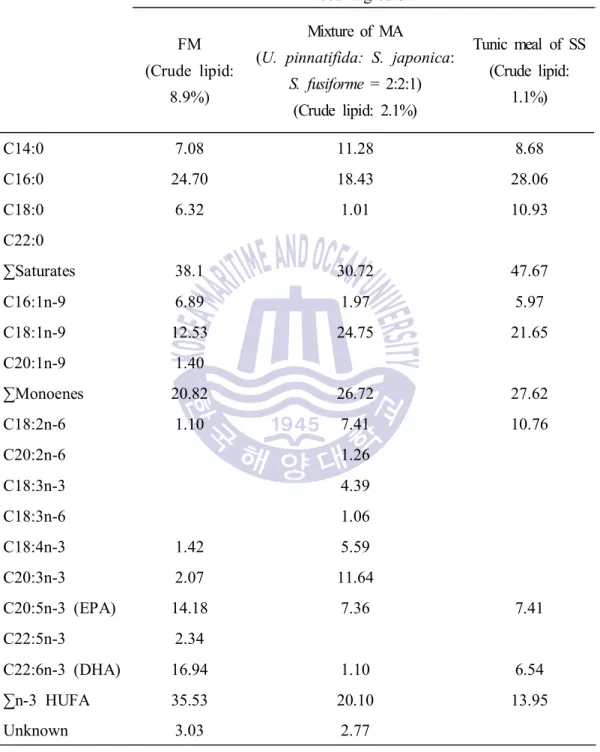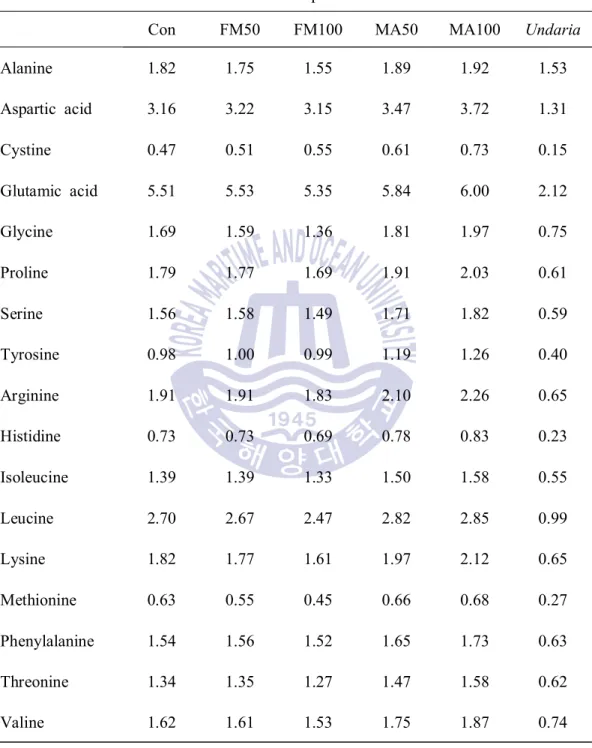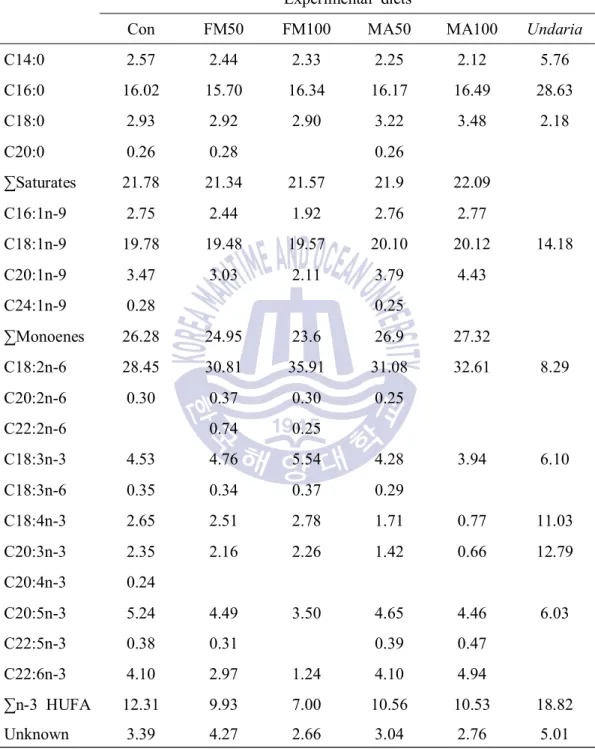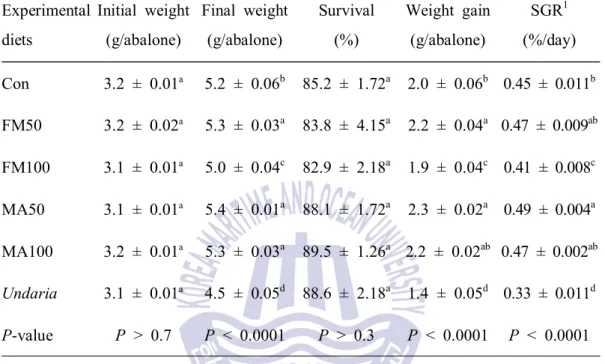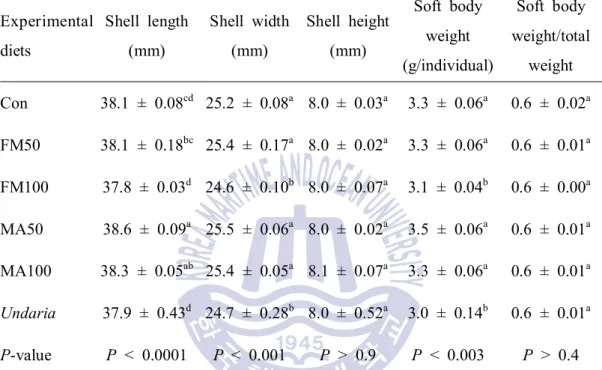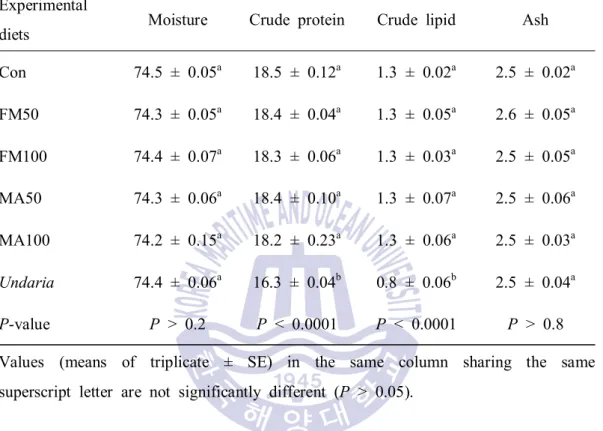Haliotis discus spat용 EP(압출 펠릿) 사료에 어분과 해초 혼합물의 대체 공급원인 바다 스프레이. Halocynthia roretzi) 캡슐 분말 첨가 효과. FM50 및 MA50 사료를 급여한 실험군에 비해 Con 사료를 급여한 실험군에서 체중 증가가 더 낮았다. 이는 MA100 사료를 제공한 실험군과 비교하여 높은 수치였으며, MA100 사료를 제공한 실험군과 차이가 없었다.
실험군과 큰 차이는 없었지만, FM100과 운다리아 사료를 먹인 실험군보다는 높았다. 전복에 대한 모든 EP 식품 플롯은 해조류 식품 플롯보다 더 높은 성장을 보였습니다. 전복 가식부위의 조단백질 및 조지방 함량은 Undaria 먹이군보다 모든 EP 먹이군에서 높게 나타났다.
키워드: Haliotis discus; 생선 음식; 해초혼합물; 멍게(Halocynthia roretzi) 피부 낭종; 상업용 사료.
Introduction
Preparation of the experimental diets
Specific growth rate (SGR, % body weight gain/day) was calculated using the formula of Britz (1996): SGR = [(ln(Wf) - ln(Wi))/days fed] × 100, where ln (Wf ) = natural log of mean final weight of abalone and ln(Wi) = natural log of mean initial weight of abalone. Proximate analysis of feed components, experimental diets and abalone soft body were performed using AOAC (1990) standard practices. Shell height and the ratio of soft body weight to total weight of abalone were not significantly (P > 0.05) affected by the experimental diets.
No significant differences in the moisture and ash content of the soft body of abalone were observed (Table 8). Crude protein and crude lipid contents of the soft body of abalone were not significantly (P < 0.05) different among the EPs. 1Specific growth rate (SGR) = [(Ln(Wf) - Ln(Wi))/days of feeding]×100, where Ln(Wf) = natural log of the final average weight of abalone and Ln(Wi) = natural log of the initial average weight of abalone.
Previous studies have shown that FM up to 80% and MA (Saccharina japonica) up to 100% can be replaced with tunicate meal of SS in the experimental diets for the same species of abalone (Jang et al. Biological parameters (shell length and width, and the soft body weight) that measured in this study was well reflected by growth performance of abalone In conclusion, FM up to 50% could be replaced with tunicate meal of SS without delay in growth performance of abalone when 14% FM was included.
All EPs replacing FM and MA with tunica meal of SS, respectively, obtained better performance of abalone over Undaria. Effect of the different sources of dietary additives on growth, body composition and shell color of abalone Haliotis discus hannai. Effects of experimentally formulated diet, commercial diet and natural diet on growth and body composition of abalone (Haliotis discus hannai).
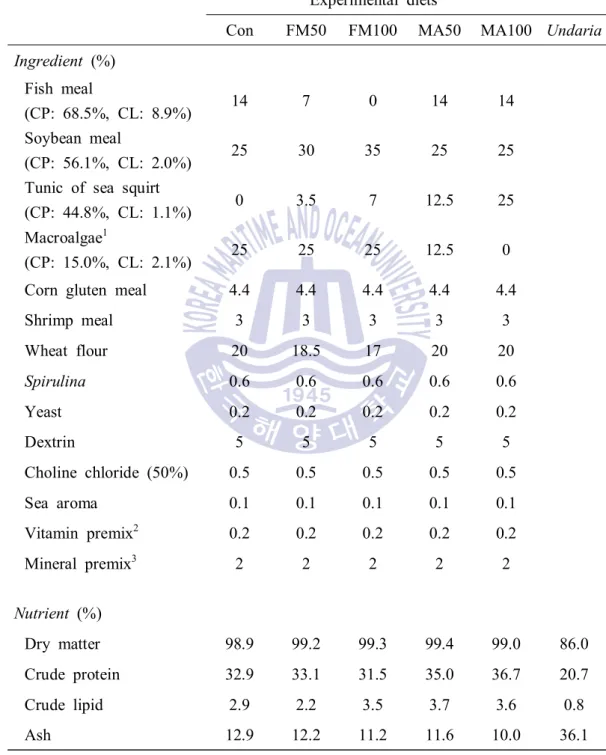
Analytical procedures of the diets and soft body
Statistical analysis
Results
At the end of the 16-week feeding trial, survival of abalone fed all experimental diets ranging from 82.9 to 89.5% was not significantly (P > 0.05) affected by dietary substitution of FM and mixing of MA with tunicate meal of SS (Table 6). Weight gain of abalone fed the MA50 and FM50 diets was significantly (P < 0.05) greater than that of abalone fed the Con and FM100 diets and Undaria, but not significant SGR of abalone fed the MA50 diet was significant ( P < 0.05) higher than that of abalone fed the Con and FM100 diets and Undaria, but not significantly (P > 0.05) different from that of abalone fed the FM50 and MA100 diets. The longest shell length was obtained in abalone fed the MA50 diet, followed by the MA100, FM50, Con and FM100 diets and Undaria (Table 7).
The tender body weight of abalone fed the Con, FM50, MA50 and MA100 diets was heavier than that of abalone fed the FM100 and Undaria. However, crude protein and crude lipid content of the soft body of abalone fed the all EPs was significantly (P < 0.05) higher than that of the soft body of abalone fed the Undaria. Shell length, shell width, shell height, soft body weight and the ratio of soft body weight to total weight of abalone (Haliotis discus) fed the experimental diets by replacing fishmeal (FM) and mixture of macroalgae (MA) with tunicate meal from sea spray (SS) ) for 16 weeks.
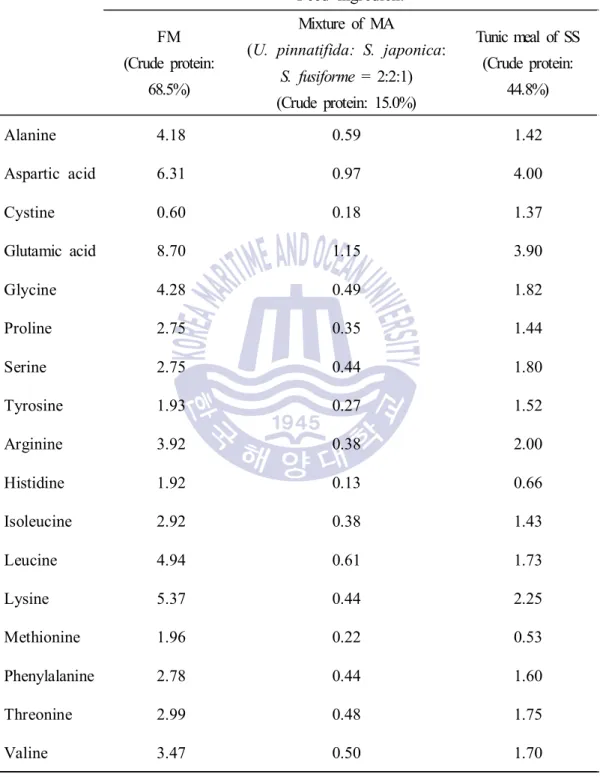
Discussion
The high essential and non-essential AA and FA contents of all EPs compared to Undaria probably resulted in the improved weight gain and SGR of abalone in this study. These results agreed with a previous study showing that the essential protein (AA) and lipid (FA) content of nutritionally balanced formulated diets was sufficient to improve the growth of abalone compared to natural diets (Viana et al. 1993; Lee et al. al. 1997;. The improved and reduced body weight gain of abalone fed FM50 and FM100 diets, respectively, compared to the Con diet in this study indicated that FM replacement up to 50% could be replaced with tuna meal from SS to improved abalone body weight gain, but further substitution slowed abalone growth when 14% FM was included in EP.
The low content of most of the essential AAs, such as arginine, histidine, isoleucine, leucine, lysine, methionine and valine, in the FM100 diet compared to the Con diet could be the reason for the lower body weight gain of abalone fed the former compared to the latter in this study. 1995b) supplementation of a mixture of synthetic amino acids such as arginine, methionine and threonine in abalone diets improved the growth characteristics of abalone, H. Similarly, tuna by-product meal and combined dry macroalgae (Nannochloropsis oceanica) biomass residue and casein could replace FM up to 75% and completely (100%) respectively in a formulated diet without growth retardation of the same species of abalone, Haliotis discus (Jung et al.
Guzman & Viana (1998) also reported that feeding a diet containing abalone viscera silage as an alternative FM source resulted in improved growth performance of abalone (H. fulgens). No difference in weight gain and SGR of abalone fed MA100 and Con diets and the best growth performance was achieved in abalone fed MA50 diet in this study showed that the MA mixture could be completely replaced with tunicate meal of SS without negative effect on growth. performance of abalone when 25%. MA mixture was included and 50% replacement of MA mixture with SS tunicate could promote weight gain and SGR of abalone. Also reported was the availability of white radish by-product (33.6%) (Lee et al. 2018) and contaminated MAs, such as Sargassum horneri (60.8% carbohydrates) and Ulva australis (58.0% carbohydrates) (Ansary et al. 2018a, b) as a suitable ingredient to replace Undaria in the diet.
The MA used in this study are the mixture of U. japonica was used in the latter, respectively. 2017 study) reported that the mean SGR of calves fed EPs replacing a mixture of MA (U. pinnatifida: S. fusiforme = 1:1) with rice bran was lower than that of calves fed diets formulated by replacing S. In the previous study, the growth of biological criteria of abalone agreed with the best growth performance of abalone (Cho 2010; Myung et al. The higher content of crude protein and lipids in the soft body of abalone fed EPs compared to Undaria in this study can be explained by the poor nutritional quality and the quality of essential and fatty amino acids in the latter, and agreed with other studies showing that the nutritional balance diet positively affects the chemical composition of abalone (Mai et al.
Conclusion
Acknowledgements
Effects of food type and temperature on the growth of juvenile abalone, Haliotis discus hannai Ino. Feeding Iberian×Duroc crossbred pigs with crude glycerol: Effects of diet and gender on carcass and meat quality. Dietary replacement effect of sea kelp (ST) (Laminaria japonica) with sea squirt (SS) tunicate (Halocynthia roretzi) on growth and carcass composition of juvenile abalone (Haliotis discus, Reeve 1846).
Growth and body composition effects of tuna by-product meal replaced by fish meal in the diet of juvenile abalone, Haliotis discus. Effects of experimental diets, commercial diets and algae (Undaria) on growth and body composition among juvenile abalone (Haliotis discus, H. sieboldii and H. discus hannai). The effects of ascidian tunicate shell supplementation to laying hen diets on egg quality.
Effect of dietary replacement of sea bran (ST), Laminaria japonica with rice bran (RB) on the growth and body composition of juvenile abalone (Haliotis discus). Effects of replacing fishmeal (FM) and macroalgae (MA) with soybean meal and rice bran in a commercial juvenile abalone (Haliotis discus hannai) diet on growth performance. Effects of partial replacement of fishmeal with soybean meal, with or without heat killing.
Effects of feeding sweet potato (Ipomoea batatas) vines as a supplement on feed intake, growth performance, digestibility and carcass characteristics of sidama goats fed a basal diet of natural grass hay. Interaction effects of dietary lipid level and temperature on growth, body composition and fatty acid profile of rohu, Labeo rohita (Hamilton). Effects of heating conditions on fatty acids and volatile compounds in foot muscle of abalone Haliotis discus hannai Ino.
